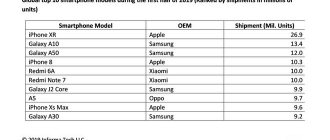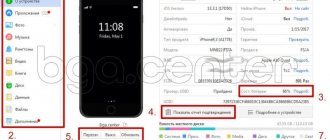The Chinese manufacturer Oppo K1 smartphone belongs to the middle price class. Manufacturers of the brand are distinguished by their special attention to the design of their models. The hero of the review was no exception.
A smartphone with a large diagonal AMOLED matrix and a modern processor does not have elements common to many phones, such as a Type-C connector or an NFC chip. The model is intended for the Chinese market and belongs to expensive smartphones in the budget range.
Equipment
Charger 5V/2A, Micro-USB cable, card tray eject clip, simple silicone case.
A couple more photos
Appearance
| Weight | 170 g |
| Size | 154.5 x 73.8 x 8.4 mm |
| Protection | No |
Two colors - red (like mine) and black.
Plastic. I love this one. Matte, not too slippery. And there are no fingerprints visible. Beauty.
There is no signal LED.
The camera block protrudes, and quite a bit. If without a case, then the smartphone cannot lie flat on a flat surface and sways slightly.
Boring details
Back surface. There is a camera block hidden in the lower left corner. In the center is the OPPO logo. There is nothing else.
Above the screen is a small teardrop-shaped cutout that houses the front camera. Above the cutout is a speaker. Nearby on the edge (to the right of the cutout) are light and proximity sensors.
Below the screen is empty.
Top edge. It's empty here too.
Bottom edge. Speaker, microphone, 3.5 mm audio output, Micro-USB connector.
Right side. Lonely power button.
Left side. A pair of volume control buttons and a triple card tray (two Nano-SIM plus a Micro-SD memory card).
Oppo A1k
The new budget-class smartphone has a stylish design of a modern device and basic functions - bells and whistles.
Appearance of the smartphone
The monoblock plastic case is made in a matte shade of the budget line of devices. Unlike expensive devices, you don’t have to worry about scratches on the back cover, fingerprints and stains like on a mirror surface. If you use the device without a case, even after a year the case will be “in excellent condition.” The only speaker is located at the bottom end. There is also a 3.5 mm headphone jack and Micro USB charging.
Screen
The appearance of the screen is quite compact, the aspect ratio is slightly elongated and is 19.5:9. The effect is enhanced by a thin frame around it and a teardrop-shaped cutout. If you remove touch buttons in the settings and set gesture controls, the useful screen space will increase to the maximum. The screen diagonal is 6.1 inches. IPS matrix with HD+ resolution size 1560x720, 282 ppi, number of colors – 16 million. For protection, tempered Corning Gorilla Glass is installed, on top of which an oleophobic coating is applied. It is the coating that protects the screen from dirty hands and the appearance of fingerprints on it. When tilted at an angle, everything is visible clearly and clearly, there is no pixel grain, and small print is readable. A small minus is that the minimum brightness is not enough. As for the color shades, they are natural and do not strain the eyes, even if you look at the screen at a strong angle. The sensor works clearly even from the slightest touch of a finger. The function is provided by an acceleration sensor (G-sensor).
Device memory
The storage inside the device has a size of 32 GB. RAM is 2 GB. The memory is expandable by installing an additional microSD, microSDHC, microSDXC card with a capacity of up to 256 GB.
CPU
The eight-core MediaTek MTK6762R (Helio P22) processor with a frequency of 2.0 GHz is equipped with an IMG GE8320 GPU chipset of medium functionality. With these characteristics, 8 cores are enough to work in applications, send messages in an email client or instant messengers. When moving the screens, there is no smoothness; switching occurs with a slight delay.
Functionality, interface and its capabilities
The smartphone works with two nano-sized SIM cards. 2G, 3G and 4G (LTE) standards are supported. The front camera is capable of recognizing the user's face. At first, the function works slowly, with constant use it “accelerates”, and the screen instantly switches from standby mode. The function is suitable during daylight hours. Unlocking will take place without problems if there is sufficient lighting indoors or outdoors. In other cases, the smartphone works after entering the password. The password is also suitable for particularly irritable users, because face unlocking is instantaneous. Among the missing functions of the gadget is fingerprint scanning. Simplicity and ease of operation, quick access to commands and services, a variety of animations - based on Android 9.0, the latest version of the ColorOS 6.0 shell is installed. 90% of the text in it is translated into Russian. The built-in application allows you to quickly change the theme. When studying the settings and their number, you can note a slight overkill. Having installed all the necessary ones “for yourself”, the rest will not interfere. There are inconveniences when setting up alerts in applications and replacing the standard calls and messages application. After the appropriate settings, the system will reset them to standard applications or not send notifications from those installed by the user. There is a quick launch button for the camera, gallery, screen recording - all these are functions of the “smart assistant”. All software text is in Russian, which is quite important for budget-class Chinese smartphones. The “games” application allows you to improve the performance of the gadget and disable notifications. The app cloning feature allows you to use two accounts on one device. In Hyper Boost “smart driving” mode, the smartphone will independently manage notifications and calls while traveling. The mode is activated when the device is connected to the car via Bluetooth. Additional functions include a pedometer, electronic compass, accelerometer, light sensor and proximity sensor.
Video and photo
Video quality is recorded in FullHD mode with a size of 1920x1080 pixels. The camera operates without image stabilization during shooting. The function is important when shooting in extreme conditions, as when using an action camera. The average user will not notice any twitching when shooting nature or outdoor views. That's what the manufacturer is counting on. Shooting mode - Full HD, frame per second - 30 frames per second. The image will not jump from frame to frame, the movements will be slightly blurred. You will get a clearer picture if you move the camera smoothly and without sudden shocks. Front camera – 5 MP, main – single, 8 MP. When taking photographs, excellent color reproduction is observed. Portrait photography is achieved with a blurred background. When examining photographs of landmarks, you can see blurring of small details in the background. In good lighting, the background is clear. In night shooting mode, glare from burning lanterns and lamps enters the frame. For professionals this is a noticeable factor, so the camera is intended for amateurs. Photos look especially good in sunny weather. The smartphone has an automatic HDR function, which adds saturation and brightness to pictures. The front camera takes slightly worse pictures. If a smartphone user has an Instagram profile, then selfies from the front camera will fit perfectly on the page or in stories.
Sound
The mono speaker has loud sound. The volume adjustment is uneven: at first the sound is quiet, then suddenly becomes loud. The location on the left on one side causes slight discomfort for right-handed people: when watching videos and playing games, the smartphone will have to be turned in a direction that is unusual for them. Those who like to listen to the radio will love the smartphone due to its built-in tuner.
Communications
The device has wireless Wi-Fi 802.11 b/g/n, which will help you stay connected in any public place with free Internet if the user has run out of traffic. When traveling in a car, the driver can use a wireless headset connected via Bluetooth v4.2 without violating safety rules when driving.
Navigation system
Along with conventional GPS and Internet navigation systems A-GPS, GLONASS and Beidou are used.
Battery model
4000 mAh – battery capacity. With such power, the gadget can work for a day or two in activity mode. Autonomous work is distributed as follows: watching a video can last up to 13 hours, game mode at average brightness and contrast values takes only 17% of the charge within an hour, in talk mode the charge will last up to 35 hours, in standby mode – up to 380 hours. Long work is due to the average screen resolution and undemanding hardware. To increase battery life, an energy-saving mode is provided: geolocation, its services, and unused utilities are turned off. The user can set their own settings to save battery power until the next charge, for example, when traveling for a long time.
Dimensions and weight
The plastic case is quite thick due to the fact that it contains a battery of decent capacity. The overall dimensions of the device are 154.5x73.8 mm, thickness - 8.4 mm. The weight of the device is only 170 g.
What's included
The practical matte surface of the case allows you to use your smartphone without a case. But the manufacturer respects its clientele so much that this accessory is already included when purchasing the device. The box contains a charger and a cable for connecting to a PC.
Advantages:
- compact;
- The battery has a large capacity and holds a charge well;
- in active mode, charging lasts for a day or two;
- excellent functionality;
- the operating system for all programs and applications is made in Russian;
- high-quality sensor – responds well to finger touches;
- case included;
- price-quality ratio;
- well-functioning software;
- good camera for little money;
- pleasant appearance;
- The large screen is made almost without frame.
Flaws:
- there is no fingerprint scanner;
- no image stabilization when recording video;
- many settings in the ColorOS shell;
- notifications in third-party applications do not always work correctly;
- Micro USB port for charging.
Communication with the outside world
| 4G | LTE Bands 1,3,5,7,8,20,28,38,40,41 LTE |
| 3G | UMTS 850, 900, 2100 HSDPA, HSUPA |
| WiFi | b/g/n, 2.4 GHz |
| Bluetooth | v4.2, A2DP |
| USB | Micro 2.0 |
| USB-OTG | + |
| MHL | — |
| NFC | — |
With communication it’s modest, so what can we say. Single-band Wi-Fi, outdated Micro-USB. And no cashless payments - NFC is also absent.
Technical specifications OPPO A1k
- Processor: 8-core MediaTek Helio P22 (MTK MT6762R) with a clock speed of up to 2.0 GHz.
- Video accelerator: IMG GE8320.
- RAM: 2 GB.
- Internal memory: 32 GB + support for microSD cards up to 256 GB.
- Display: IPS, 6.1 inches, 1560 x 720, pixel density 282 ppi, Corning Gorilla Glass 3.
- Main camera: 8 MP, f/2.2 aperture, 1.4 micron, 1080p video recording.
- Front camera: 5 MP, f/2.0 aperture, 1.12 micron, 720p video recording, SelfieTune technology.
- System: Android 9.0 Pie with proprietary ColorOS 6.0 interface.
- Battery: 4000 mAh.
- Wi-Fi (2.4 GHz), Bluetooth 4.2, GPS, A-GPS, Beidou, GLONASS, 4G Bands 1/3/5/7/8/20/28.
- SIM card: support two nanoSIM and microSD simultaneously.
- Protection: face unlock.
- Dimensions: 154.5 x 73.8 x 8.4 mm.
- Weight: 168 grams.
- Official price: 9990 rubles.
In addition to the smartphone, the box contains:
- Charger.
- MicroUSB power cable.
- Transparent silicone case of good quality.
- SIM tray eject tool.
- User manual.
- Warranty card.
Screen
| Matrix | S-IPS |
| Diagonal | 6.1″ |
| Permission | 720×1560 |
| PPI | 282 |
| Multi-touch | 10 |
| Max white brightness | 320 cd/m2 |
| Min white brightness | 3 cd/m2 |
| Contrast | 910:1 |
| Color temp. | 6500-9200K |
| Gloves | No |
Normal matrix of average class, average brightness, average resolution. In short, everything is average.
There is film on the screen. And, it seems, even with some kind of coating. Those. the prints remain, but not exactly horror-horror. So I didn’t peel it off.
By the way, the piece of glass is not just unclear what kind, but a whole third-generation Gorilla Glass. A trifle - but nice.
Specifications
Name
— Oppo K3
Code name
— PCGM00
Release date
— 2020, May
Predecessor
— Oppo K1
Operating system
— Android 9.0 P
Corporate shell
— ColorOS 6
Screen
— 6.5″, AMOLED, 1080×2340, Gorilla Glass
Processor
— Snapdragon 710, Octa-Core 2.2 GHz
Video processor
— Adreno 616
RAM
— 6 gb LPDDR4X
Permanent memory
— 64 gb
Fingerprint scanner
— on-screen
Rear camera
— 16 Mpx ƒ/ 1.7 + 2 Mpx ƒ/ 2.4
Front camera
— 16 Mpx ƒ/ 2.0
Slow motion video (SlowMotion)
— 240FPS
Wireless communication
– WiFi 2.4 + 5GHz, Bluetooth 5.0
Navigation
– A-GPS, Beidou, Galileo, GLONASS, GPS
Headphone output
– AudioJack 3.5mm
Cable connector
– Type C
Supported SIM cards
– Nano + Nano
Battery
– 3765 mAh
Fast charging
— VOOC 3.0 flash charge 20W (5V/4A)
Dimensions
— 76.0 mm • 161.2 mm • 9.4 mm
[TOP]
Operating system and other software
Android is fresh, 9.0 Pie. Plus the proprietary ColorOS 6.0 shell. Updates are arriving. Everything is fine.
A few more screenshots
A few minor little things.
I was a little surprised by the set of pre-installed third-party applications. In addition to traditional Facebook, there was, in particular, Indonesia Airports software... However, there were no problems with cleaning the smartphone from unnecessary things.
In addition to Google, there is also a native application store. What's a little strange is that it's not localized. Everything... no, not in hieroglyphs, but in English. However, it is still unlikely that there will be many people willing to use it.
Another small thing. I wonder who thought of setting such a faded wallpaper by default? I can understand a lot, but when you pick up the phone and can’t see the Android buttons, because... they merged with the wallpaper, it's strange. It is clear that the problem is solved in three seconds - even among the pre-installed wallpapers, you can easily select something. But the fact itself is a little strange.
I also want to congratulate the interface developers for having excellent vision. Personally, I discern the percentage of battery charge shoved inside the indicator with some difficulty.
Smartphone characteristics:
| Characteristic name | Options |
| Screen resolution | 1560x720 megapixels |
| Display | TFT, 16 million colors |
| Screen Matrix | IPS with HD+ |
| Screen size | 6.1 inches |
| Number of cameras | 2 |
| Primary resolution | 8 megapixels |
| Front Resolution | 5 megapixels |
| Video quality | 1920×1080 Pix (FullHD) |
| Number of SIM cards | 2 |
| CPU | MediaTek MTK6762R |
| operating system | Android 9.0 |
| Shell | ColorOS 6.0 |
| RAM | 2 GB |
| Built-in memory | 32 GB |
| Memory card | microSD, microSDHC, microSDXC |
| Memory card capacity | 256 GB |
| Navigation | GPS/A-GPS/GLONASS/Beidou |
| Wireless interfaces | Wi-Fi, Bluetooth |
| Battery | 4000 mAh |
| Microphone and speaker | available, with mono sound |
| Headphone jack | 3.5 mm |
| Additional functions | pedometer, electronic compass, accelerometer, light sensor, proximity sensor, flashlight, fingerprint scanner |
| dimensions | 154.5 x 73.8 x 8.4 mm |
| Weight | 170 gr |
| Price | 9990 rubles |
Oppo A1k
Battery
We're getting used to it. Smartphones based on MediaTek chips can also be energy efficient.
Is there a good battery capacity - 4000 mAh? Get great uptime. My battery tests gave 241% of the conventional standard. Excellent result.
The only weak point is the heavy toys. And even that is relatively weak. But, at least with their help, it is possible to discharge a smartphone in one day.
The device easily lasted me two days. There was still a little left.
| Full discharge time | Discharge in an hour | |
| Video | 17:30 | 5.7% |
| Video HD | 14:50 | 6.7% |
| Easy game | 12:10 | 8.2% |
| Hard game | 7:40 | 13.0% |
| Telephone | 29:10 | 3.4% |
| Music | 116:50 | 0.9% |
| GPS on 3G window | 10:10 | 9.8% |
| GPS on Wi-Fi window | 12:30 | 8.0% |
| White screen | 21:50 | 4.6% |
| White screen 100% | 11:20 | 8.8% |
| Internet 3G | 11:00 | 9.2% |
| Internet Wi-Fi | 15:20 | 6.5% |
| Slow torrent Wi-Fi | 95:00 | 1.1% |
Errors when flashing stock ROM via MSM Download Tool
- The connection time has expired.
- Microsoft status shows offline even when connected to a Wi-Fi network.
- The Start button won't do anything several times.
- MSMDownload Oppo A71 Qualcomm Snapdragon Connect Timeout Error Fixed.
- Fix MSMDownload unauthorized and hidden start button.
- A warning always appears: "You must use authorized accounts such as A3S, F5, F7, F9, etc."
Now we have shared the pre-requirements for flashing stock firmware via MSM Download Tool.
Pre-requirements:
- Take a complete backup of your device data before doing anything. The flashing process will delete all images, videos, documents and other data from the internal storage of your device.
- Charge your device's battery to at least 60%.
- You will need a PC/laptop and a USB cable.
- Be sure to download MSM Tool on your computer.
- Download and install Android USB Drivers on your computer.
Download links:
MSM Download Tool – Direct Link | Mirror MSM Download Tool 4.0.58: MSM Download Tool 5.0.15: Download
OPPO A1k as a photo and video camera
| Rear: | 8 MP f/2.2 1/3.2″ |
| Frontal: | 5 MP f/2.0 1/5″ |
Amazing thing. The camera is not only single, but also “only” eight megapixel.
The camera is actually quite good. Normal, pleasing to the eye pictures. And even at low lighting levels. It is clear that the A1k will not be able to compete with serious expensive smartphones. But for a device costing ten thousand, the image quality is more than acceptable.
And the fact that they didn’t pursue inflated megapixels is probably for the best. And I don’t plan to miss the “depth” cameras.
Original full-size photographs
The front is weak.
Original full-size photographs
Photo duels:
- A1k vs Redmi Note 7
- A1k vs BQ 6040L Magic
- A1k vs Vivo Y91C
Other Features
The smartphone runs on Android 10 with the proprietary ColorOS 7 shell, which pleases with its speed and minimalistic interface. The manufacturer also took care of optimization so that the device does not slow down over time.
OPPO A72 is built on the Qualcomm Snapdragon 665 hardware platform, made using an 11-nanometer process technology. The chipset is equipped with eight Kryo 260 cores with a frequency of up to 2 GHz, an Adreno 610 graphics accelerator and a coprocessor for running neural networks. This SoC has proven itself in mid-priced smartphones, so you can expect decent performance in everyday use.
The new product has 4 GB of RAM standard LPDDR4X, and the internal storage capacity of UFS 2.1 is 128 GB. The gadget also received NFC and supports contactless payment via Google Pay.
Photo: Artyom Bagdasarov / Lifehacker
A 5,000 mAh battery powers all components. Although the IPS screen consumes more energy than OLED matrices with similar characteristics, battery life should be decent. The smartphone comes with an 18 W adapter, which replenishes 50% of the charge in 45 minutes.
OPPO A1k as a GPS navigator
Perhaps for sunny weather I would like a little more brightness. However, it’s a sin to complain. So the A1k navigator turned out to be almost perfect - smooth tracks, fast acquisition of satellites, support for all major satellite systems. The screen and battery are also at the proper level. In short, everything is fine.
Test tracks
OPPO A1k like a toy
The smartphone is moderately gaming-friendly. We've seen better. But you can play almost everything. Although, of course, not every toy needs to turn the graphics settings to maximum.
| A game | Problems? |
| Asphalt 8: Take Off | 27-28 FPS on maximum graphics. |
| Dead Trigger 2 | On average, a confident 30 FPS on maximum graphics, but still occasionally there are lags. It doesn't allow me to set it to 60 FPS. |
| World of Tanks Blitz | Around 45 FPS on max graphics with minor fluctuations here and there. |
| PUBG Mobile | About 25 FPS with slight lags (up to 20 FPS) on the Balanced/Medium chart. |
| World of Warships Blitz | On average 27 FPS on maximum graphics, ranging from 25 to 35 FPS. |
| Into the Dead 2 | On maximum graphics there is only 7-8 FPS, it is impossible to play. On medium - 16-17 FPS. Tolerable, but not enthusiastic. If you try to set the graphics to minimum, the toy starts to glitch - the interface no longer fits on the screen. |
Traditional thanks to Gamebench for the opportunity to measure FPS. This time, however, it turned out to be difficult. It seemed like the system was stubbornly killing unnecessary processes, which is why Gamebench had to be constantly restarted.
Camera
There are two cameras on the back of the smartphone.
One is 16Mp with a wide-angle aperture lens f1.7, the second is 2Mp with an aperture f2.4. Front camera 16MP with f2.0 aperture [TOP] Interface
The main interface of the standard Camera application. Intelligent auto-detection of faces with indicator brackets works immediately.
By tapping anywhere in the frame, focus shift and automatic exposure correction will work, while it remains possible to manually adjust it by swiping up or down next to the focus circle.
Circle x1 (x2) is the current zoom mode; by tapping on this button, a two-fold increase is available
Three dots in the left toolbar are an overlay of one of several preset photo filter presets on the image
The next three icons are “turn on brightness”, “HDR mode”, and “flash”
Toolbars on the right side. The icon of a woman’s head with an asterisk is an “improver” for softening skin defects, there is a smooth adjustment. Below are three main shooting modes - “Video / Photo / Portrait”
Hidden behind the triple stripes icon are additional photo and video shooting modes: “night/panorama/expert/fast/slow.” The last two modes are for recording Tailamps and SlowMotion videos, respectively.
Expert mode provides more advanced camera settings. On the first tab you can adjust the light sensitivity of the matrix up to 3200 ISO and shutter speed up to 1/8000. You cannot adjust the aperture here, so this is not quite a manual mode, but rather an analogue of the camera’s “shutter priority” mode. If you cannot adjust a parameter manually, then in this case there is an AUTO button to automatically adjust the parameter.
The second tab adjusts white balance from 2000K to 6000K
Third tab - manual focus adjustment
Fourth tab - exposure adjustment
When recording regular video, a choice of resolution, photo filters, ZOOM, and LED backlight are available.
If the battery is low, you will not be able to use the LED backlight. The camera icon in the circle switches to the front exit camera.
[TOP] Settings
simple. This includes turning on the timer, aspect ratio (4:3, 1:1 or full screen), geotag, signature, AI scene, selfie mirroring.
[TOP] Photo comparison: Oppo K3 VS Xiaomi Redmi Note 5
On the left are pictures from Xiaomi, on the right are from Oppo. The second one immediately stands out with more saturated colors.
[TOP] RN5vsK3: Backlit sunlight
But here the picture is more interesting: through the Xiaomi lens, objects are greatly darkened and there are vertical reflections; Oppo did an order of magnitude better in such difficult conditions.
RN5vsK3: MDF cameras
MDF is the minimum distance at which the camera is still able to focus on the object. The smaller this distance, the larger we can photograph a small object. This type of photography is called macro. The MDF of Xiaomi Redmi Note and Oppo K3 turned out to be the same ~8cm
[TOP] RN5vsK3: Test table
I positioned the table until the entire frame was filled and photographed it on both devices. Both smartphones convey details in generally the same way.
100% crops taken from the lower right corner
[TOP] RN5vsK3: SMD components
100% crop, covering three SMD resistors
[TOP] RN5vsK3: Newspaper unfolded (+flash)
Without flash
100% crop of lower right corner
With flash
100% crop of the lower right corner
[TOP] RN5vsK3: Flash operation
in complete darkness. Xiaomi in these conditions makes the photo green, in the case of Oppo the color rendition is natural.
RN5vsK3: Late sunset
The Redmi Note 5 has an aperture of f/1.9, so the ISO is raised and the shutter speed is longer + noise reduction works and the picture ends up being less clear than from an Oppo camera with an aperture of f/1.7
Sample pictures
All pictures were taken in automatic mode, sometimes +HDR, I also periodically used forced exposure adjustment (next to the autofocus circle.)
On the left is normal, on the right is HDR
Filming from the car
Cat couple
Dog
Fence
Nature
At night - as always: ISO goes up, and noise reduction “eats away” small details
[TOP] Video examples
There is no optical image stabilization when shooting video - instead there is digital stabilization, which, however, works quite well.
Example of slow motion video (SlowMotion 240fps)
Pack of originals of all photos:
[TOP]











